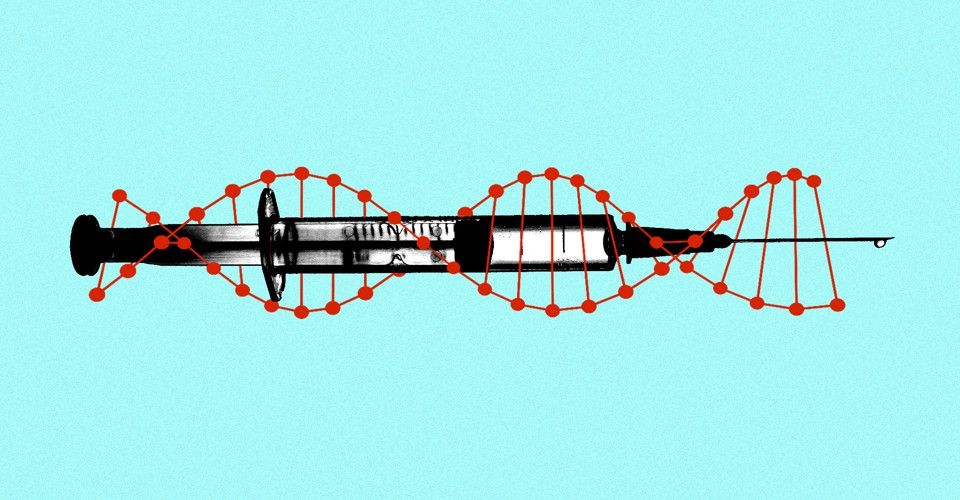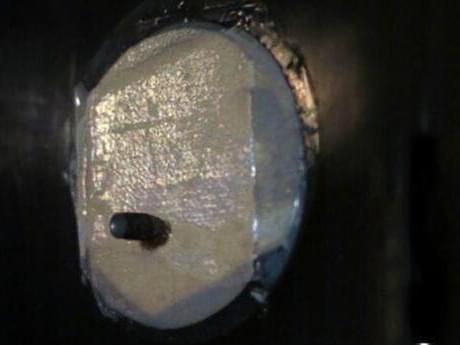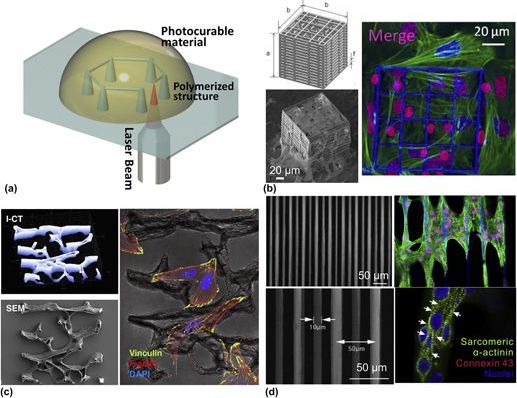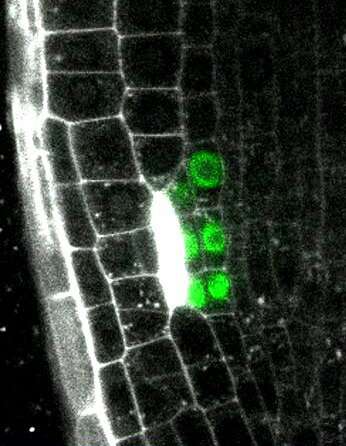Naturopaths have long been obsessed with a gene called MTHFR. Now vaccine skeptics are testing for it too.



Jalila Essaïdi is a Dutch artist and entrepreneur focused on biotech applications of spider silk, which she makes using the milk of genetically engineered goats.
Spider silk is one of the strongest materials in nature. Jalila Essaïdi had her curiosity piqued when she read about the work of Randolph Lewis, a Professor at Utah State University, who had developed a method to create synthetic spider silk from goat milk.
“We genetically engineered the goats so that they produced a spider protein in their milk. We then purify that protein from the milk and spin it into fibers,” Lewis told CNN in an interview.
Abstract: This report focuses on the effect of the surface topography of the substrate on the behavior of human mesenchymal stem cells from bone marrow (MSCs) before and after co-differentiation into adipocytes and osteoblasts. Picosecond pulsed laser ablation technology was applied to generate different microstructures (microgrooves and microcavities) on poly (L-lactide) (PLLA), where orientation, cell shape and MSCs co-differentiation were investigated. On flat PLLA, the undifferentiated MSCs showed rounded or elongated shapes, the latter being randomly oriented. On PLLA microgrooves however, MSCs adapted their shape to the groove size and direction and occasionally anchored to groove edges. It was found that adipocytes, contrary to osteoblasts, are highly sensitive to topological cues. Adipocytes responded to changes in substrate height and depth, by adapting the intracellular distribution of their lipid vacuoles to these physical constraints. In addition, the modification of PLLA by laser ablation enhanced the adherence of differentiated cells to the substrate. These findings show that picosecond pulsed laser micromachining can be applied to directly manufacture 3D microstructures that guide cell proliferation, control adipocyte morphology and improve the adhesion of bone and fat tissue.
From: Jose L. Toca-Herrera [view email]
[v1] Thu, 25 Jan 2018 23:56:53 UTC (1,069 KB)


Tony Stark (Robert Downey Jr.) is nothing if not a master innovator. After every single battle he’s had in the Marvel Cinematic Universe, the character has used his book smarts and technical wherewithal to better his suit so that it can defend against any threat the Avengers may run into. That includes the introduction of yet another suit in Avengers: Endgame after his first nano-tech based armor was destroyed in the Battle of Titan that took place in Avengers: Infinity War.
Weta Digital was the team behind crafting Stark’s layered nano-tech armor in addition to the third-act Endgame battle where we saw the majority of its capabilities. Recently, we had the chance to speak with Weta’s visual effects supervisor Matt Aitken, who helped detail what all went into making the latest iteration of Iron Man armor.
“Here in Infinity War, and then subsequently in Endgame, he’s got the Bleeding Edge nano-tech that he’s developed,” Aitken recounts.” And that’s about this idea that the suit is actually made up of these nanoparticles that can kind of form a fluid and move around on the surface of the suit, and reform different weapons, and then kind of solidify and crystallize into a rigid, metal suit. We developed that tech for Infinity War, and then really extended it for Endgame for two particular sequences.”

If plants are injured, cells adjacent to the wound fill the gaps with their daughter cells. However, which cells divide to do the healing and how they manage to produce cells that match the cell type of the missing tissue has been unclear. Scientists from the Institute of Science and Technology Austria (IST Austria) have now shown that to correctly replace dead cells, neighbors to the inside of the wound re-activate their stem cell programs.
All plant organs—from the leaves to the root—regularly endure injuries to their tissue, whether due to mechanical forces, grazing animals, or other factors. While animals rely on specialized migrating cells for wound healing, plants, whose cells are immobile, had to evolve other mechanisms.
It has been known for almost a century that in plants, cells adjacent to the wound replace harmed tissue with new daughter cells. Yet, a completely new aspect of plant wound healing in the sensitive root tip has only recently been discovered: The research team including first authors Petra Marhava, former Ph.D. student at IST Austria, current Ph.D. student Lukas Hörmayer, and former IST postdoc Saiko Yoshida reports that injured or destroyed root cells are not simply replaced by a proliferation of healthy cells from the same cell type above and below to the wound. Instead, the cells adjacent to the inner side of the injury reactivate their stem cell programs to produce de novo cells of the correct type to replace missing neighbors. The researchers termed this newly discovered restorative cell division process “restorative patterning.”


Global Organs-on-chips Market Size, Status and Forecast 2019–2025
The report provides insightful details – how clients enhance their basic leadership capacity within the worldwide Organs-on-chips Market business. Utilizing figures and flowcharts are brief in this report, the specialists represented to the analyzed information in a superior acceptable manner. This report identifies that rapidly changing market trends and competitive landscape with growth significant CAGR during Forecast. Along, with latest marketing factors those are essential to monitor market performance and crucial decisions for progress and profitability.
According to this study, the next Y-o-Y (year over year) Organs-on-chips market will register a XX% CAGR in terms of revenue, the Astonishing Growth market size will reach US$ XX million by 2025, from US$ XX million in 2019. In particular, this report presents the global market share (sales and revenue) of key companies in the Market New Research Study.
UCLA researchers have discovered a new way to activate the stem cells in the hair follicle to make hair grow. The research, led by scientists Heather Christofk and William Lowry, may lead to new drugs that could promote hair growth for people with baldness or alopecia, which is hair loss associated with such factors as hormonal imbalance, stress, aging or chemotherapy treatment.
The research was published in the journal Nature Cell Biology.
Hair follicle stem cells are long-lived cells in the hair follicle; they are present in the skin and produce hair throughout a person’s lifetime. They are “quiescent,” meaning they are normally inactive, but they quickly activate during a new hair cycle, which is when new hair growth occurs. The quiescence of hair follicle stem cells is regulated by many factors. In certain cases they fail to activate, which is what causes hair loss.

Choriocapillary loss is a major cause of neovascular age-related macular degeneration (NV-AMD). Although vascular endothelial growth factor (VEGF) blockade for NV-AMD has shown beneficial outcomes, unmet medical needs for patients refractory or tachyphylactic to anti-VEGF therapy exist. In addition, the treatment could exacerbate choriocapillary rarefaction, necessitating advanced treatment for fundamental recovery from NV-AMD. In this study, Tie2 activation by angiopoietin-2–binding and Tie2-activating antibody (ABTAA) presents a therapeutic strategy for NV-AMD. Conditional Tie2 deletion impeded choriocapillary maintenance, rendering eyes susceptible to NV-AMD development. Moreover, in a NV-AMD mouse model, ABTAA not only suppressed choroidal neovascularization (CNV) and vascular leakage but also regenerated the choriocapillaris and relieved hypoxia. Conversely, VEGF blockade degenerated the choriocapillaris and exacerbated hypoxia, although it suppressed CNV and vascular leakage. Together, we establish that angiopoietin-Tie2 signaling is critical for choriocapillary maintenance and that ABTAA represents an alternative, combinative therapeutic strategy for NV-AMD by alleviating anti-VEGF adverse effects.
Neovascular age-related macular degeneration (NV-AMD) is a leading cause of irreversible vision loss among elderly persons in developed countries. NV-AMD is characterized by the formation of choroidal neovascularization (CNV), an ingrowth of abnormal blood vessels from the choroid through Bruch’s membrane into the sub-retinal pigment epithelium (RPE) or subretinal space. Throughout this ingrowth, abnormal leakages of fluids and bloods occur into the retina, causing vision distortion and loss of central vision (2, 3). To treat neovascular eye diseases including NV-AMD, anti–vascular endothelial growth factor A (VEGF) therapy has largely been used based on the fact that an excessive production of VEGF from hypoxic cells in the retino-choroidal complex is critical in the pathogenesis and features of neovascular eye diseases (3, 4).